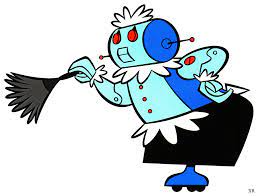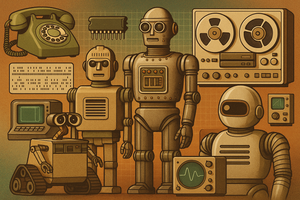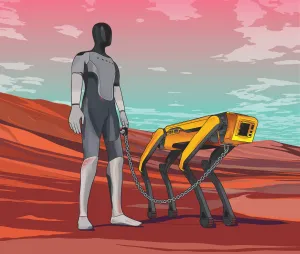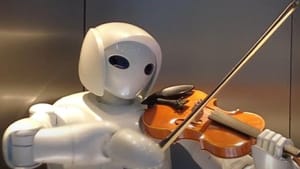Our time machine journey begins with the birth of the industrial robot, a defining moment in the history of robotics. The star of this part of our story? None other than the Unimate, the first-ever industrial robot.
The Unimate, developed by American inventor George Devol, and brought to life by entrepreneur Joseph Engelberger, was a mechanical behemoth designed to perform repetitive tasks with accuracy and consistency that was simply unachievable by human workers. In 1961, it stepped into the limelight, taking its place on a General Motors assembly line and forever changing the landscape of manufacturing and industry.
But the Unimate was just the beginning. It opened the door to a new era of automation, paving the way for subsequent innovations and laying the groundwork for the advanced robotics we see today. It was, to borrow a phrase from Stanley Kubrick's groundbreaking 1968 film 2001: A Space Odyssey, like unlocking a previously sealed "pod bay door" and stepping into a realm of untapped potential.
Yes, the 1960s was a time of exploration, of pushing boundaries and, quite literally, reaching for the stars. And in the world of robotics, the sky was the limit.
Unimate
Other Significant from the 1960s
So, we've established the 1960s as the dawn of the age of industrial robotics, led by the ground-breaking Unimate. But the sixties weren't just about heavy-duty industrial machines. This transformative decade saw several other pioneering robots and technological advancements that left an indelible mark on the field.
Let's take a moment to appreciate Shakey, the "first electronic person." Developed by researchers at Stanford Research Institute (SRI), Shakey was the first general-purpose mobile robot able to reason about its own actions. While its movement was a bit on the shaky side (hence the name), Shakey’s real significance lies in its intelligence, as it could perceive its surroundings, infer implicit facts from explicit ones, generate plans, recover from errors in plan execution, and communicate using ordinary English.
The SRI team built Shakey as an experiment to investigate large problems in artificial intelligence and robotics. The robot’s hardware included a television camera, a triangulating range finder, and bump sensors. While it wouldn't win any beauty contests (unless they were strictly robot entrants), Shakey set the groundwork for the AI systems we use today.
Now, in the realm of prosthetics, the decade saw the first myoelectric artificial limb. Myoelectric prosthetics use the electrical signals generated naturally by our muscles to function. This marked a significant advancement from purely mechanical prosthetics and provided a new degree of control and functionality for people requiring artificial limbs.
And who could forget Elmer and Elsie, the tortoise-shaped robots? Built by neurologist and robotician William Grey Walter in the late 1940s, these cute little cybernetic creatures had their heyday in the 1960s. Despite their simplicity, they demonstrated complex behaviors with very simple circuitry, foreshadowing the rise of autonomous robots.
The 1960s was indeed a vibrant period for robotics, with each innovation pushing the boundaries a little further, broadening the horizon of what was considered possible. In the immortal words of a certain science officer from Star Trek,
Change is the essential process of all existence.
And the robots and technological advancements of the 1960s certainly brought about profound change in their world and ours.
Fun and Interesting Facts
Ah, I love a good trivia session! Let's dive into some delightful nuggets from the 1960s robotic world that may surprise you.
Did you know that the name 'Unimate' is actually a portmanteau of 'Universal Automation'? Joseph Engelberger and George Devol, the creators of the Unimate, believed that their invention would have universal applications across different industries1. In hindsight, they weren't far off the mark!
Shakey the robot, while famous for its problem-solving skills, moved, well, rather shakily! It was notoriously slow and could take hours to perform a simple task. Just goes to show that even robotic geniuses have their quirks or on those cases facing the limitations of the technology at their times.
The myoelectric arm wasn't just a scientific marvel; it was a life-changing invention for many. It was so effective that some versions of the technology are still in use today, helping amputees lead more fulfilling lives. Now that's what I call a lasting impact!
Not all robots of the 1960s were metal and wires. A quirky robot named 'Mr. Mercury' was a popular toy robot during this decade4. Battery-operated, it could walk, bend, and pick up magnetic objects. Talk about a fun way to get kids interested in robotics!
The 1960s were not just about making robots; they were also about dreaming of them. In 1965, Isaac Asimov published his collection of robot short stories titled 'The Rest of the Robots'. His 'Three Laws of Robotics,' introduced earlier, continue to be discussed and debated in robotics ethics.
Isn't it amazing how much color and character these facts add to our understanding of 1960s robotics? As the delightful R2-D2 from Star Wars6 would probably beep and whirr in approval, "Beep boop beep!"
The Influence of Pop Culture
If the 1960s were an explosive decade for robotics technology, they were also a time when robots took center stage in pop culture, stepping out of the science labs and into our living rooms through television and cinema. The influence of this cannot be understated, as it shaped our perceptions of robots and their place in society.
How about the Jetsons' beloved robot maid, Rosie? Introduced in 1962 in the animated sitcom, The Jetsons, Rosie was arguably one of the first depictions of a humanoid robot integrated into family life. Despite her tin exterior, she was seen as an almost maternal figure, handling household chores with aplomb and always dishing out doses of humor and wisdom. She set a precedent for the portrayal of domestic robots as friendly, helpful companions.

Then, there was the slightly more unnerving HAL 9000 from 2001: A Space Odyssey.

HAL, a sentient computer onboard a spaceship, is a cautionary tale about the potential dangers of artificial intelligence. He makes us question the moral and ethical implications of giving machines too much power or control. Even though HAL is an AI and not a physical robot, the questions it raised directly relate to the field of robotics, highlighting the complexities of our evolving relationship with technology.
It's fascinating, isn't it, how these cultural depictions of robots in the 1960s mirrored the hopes, fears, and aspirations of the society at the time? They reflected the optimism for a future where robots could make our lives easier, and simultaneously, the anxieties about the potential risks and loss of control.
As I reminisce about these portrayals, I can't help but quote the great HAL 9000 himself:
I am putting myself to the fullest possible use, which is all I think that any conscious entity can ever hope to do.
Real-World Applications and Developments
Let's now navigate from the world of pop culture back into the real one. We've touched upon industrial robots and a few innovative inventions, but the 1960s saw an even wider range of practical applications for robots.
In the world of space exploration, robotic technology had its first real test. NASA's Ranger program, initiated in 1959, truly came into its own in the mid-1960s.
These were unmanned spacecraft designed to take high-resolution images of the moon's surface to select safe landing sites for the Apollo missions.
Although the first few Rangers failed, Rangers 7, 8, and 9 successfully completed their missions, demonstrating the potential of robotics in space exploration.
On a more down-to-earth note, robotic technologies found applications in the medical field as well. The 1960s saw the first experiments in robotic surgery, with robots assisting in precision tasks.
It was an early start, and although the robots weren't as sophisticated as today's surgical robots, they were an indication of the vital role robotics would play in healthcare.
Finally, in manufacturing, robots expanded their roles beyond the automotive industry, finding a place in electronics manufacturing. They performed tasks like assembly and quality control, increasing efficiency, and reducing human error.
These applications show us that even in the early stages, robotics wasn't just about replacing human effort but enhancing it. Robots were built to do tasks beyond human capabilities or to do mundane tasks more efficiently.
I can't help but chuckle at this thought. Reminds me of something Agent K said in Men in Black:
"A person is smart. People are dumb, panicky, dangerous animals, and you know it."
Robots, in a way, help us mitigate some of our 'human' fallibilities.
Reflection and Legacy
As we step back from the buzzing and whirring world of 1960s robotics, we're left with a rich legacy that continues to inspire, inform, and instruct.
The dawn of industrial robotics, symbolized by the Unimate, changed the course of manufacturing forever, setting the stage for today's automated factories.
As I recall the clunky yet groundbreaking Unimate, I remember a line from the movie Transformers:
"There's more than meets the eye."
Indeed, Unimate was more than a hunk of metal; it was a trailblazer that proved robots could work side-by-side with humans in factories.
The innovations of the 1960s, like Shakey, the myoelectric artificial limb, Elmer and Elsie, and the forays into space and surgical robotics, marked the diverse potential of robotics. Each innovation, each 'first', taught us something new about how robots could enhance our capabilities and transform our lives.
The pop culture depictions of robots, from Rosie to HAL 9000, not only reflected our aspirations and anxieties around robots but also shaped our expectations and attitudes towards them.
They helped bring robotics into mainstream conversations and sparked imaginations worldwide.
The practical applications of robotics during the 1960s showed us the tangible benefits of these technologies. They provided valuable insights into the challenges of implementing robotics in real-world scenarios and highlighted the importance of designing robots that augment human capabilities rather than merely replacing them.
As we navigate our present and future with robots, the 1960s serve as a powerful reminder of the importance of innovation, ambition, ethical considerations, and adaptability.
As the iconic Star Wars droid C-3PO3 once said,
"We seem to be made to suffer. It's our lot in life."
But with the right approach to robotics, we can perhaps make life a bit less about suffering and a lot more about thriving.
As we conclude this journey through the 1960s, we can see how this decade shaped the trajectory of robotics. The innovations and applications from this period laid the groundwork for the sophisticated robots we see today. But this era was more than just the sum of its technological advancements. It represented a shared dream of humanity—to create, to innovate, to push the boundaries of what machines can do.
From the assembly lines of General Motors to the fictional corridors of The Jetsons' home, robots stepped off the pages of science fiction and into our collective consciousness.
Whether it was through Unimate's precise movements, Shakey's problem-solving skills, or HAL 9000's chilling sentience, the world got a taste of the myriad possibilities (and challenges) that lay in our coexistence with robots.
We've laughed with the likes of Rosie the Robot, cringed at the menacing HAL 9000, and marveled at the strides made in space exploration and medical robotics. We've appreciated the genius of creators and innovators who dared to dream and build. And, most importantly, we've witnessed the ever-evolving relationship between humans and robots—a relationship that continues to fascinate, surprise, and even baffle us at times.
Onward to the future, my friends. And remember, when in doubt, just think: What would a 1960s robot do?
🌴 Have a bLife moment, I am doing it as we speak #truestory 🤙🏽





